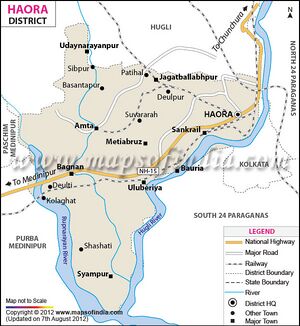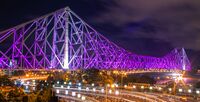Howrah
| Author:Laxman Burdak, IFS (R) |


Howrah (हावड़ा) is a city in the Indian state of West Bengal. Howrah is an important transportation hub and gateway to Kolkata and West Bengal. Howrah is the major railway station serving Howrah, Kolkata and the neighbouring districts.
Variants
Location
Howrah is located on the western bank of the Hooghly River opposite its twin city of Kolkata. Administratively it lies within Howrah district, and is the headquarters of the Howrah Sadar subdivision. It is a part of the area covered by the Kolkata Metropolitan Development Authority.
Origin
The name came from the word Haor—Bengali word for a fluvial swampy lake, which is sedimentologically a depression where water, mud and organic debris accumulate. The word itself was rather used in eastern part of Bengal (now Bangladesh), as compared to the western part (now West Bengal).[2]
History
The history of the city of Howrah dates back over 500 years, but the district is situated in an area historically occupied by the ancient Bengali kingdom of Bhurshut. Venetian explorer Cesare Federici, who travelled in India during 1565–79, mentioned a place called Buttor in his journal circa 1578. As per his description, this was a location into which large ships could travel (presumably the Hoogli river) and perhaps a commercial port. This place is identifiable with the modern day neighbourhood of Bator.[3]
Bator was also mentioned in the Bengali poetry Manasamangal written by Bipradas Pipilai in 1495.[4]
In 1713, the Bengal Council of the British East India Company, on the accession of the Emperor Farrukhsiyar, grandson of Aurangzeb, to the throne of Delhi, sent a deputation to him with a petition for a settlement of five villages on west bank of Hooghly river along with thirty-three villages on the east bank.[5] The list of villages appeared in the Consultation Book of the Council dated 4 May 1714. The five villages on the west bank on Hooghly river were: 'Salica' (Salkia), 'Harirah' (Howrah), 'Cassundeah' (Kasundia), 'Ramkrishnopoor' (Ramkrishnapur) and 'Battar' (Bator): all identifiable with localities of modern-day Howrah city.[ The deputation was successful except for these five villages. By 1728, most of the present-day Howrah district was part of either of the two zamindaris: Burdwan or Muhammand Aminpur.[6]
On 11 October 1760, as a result of the Battle of Plassey, the East India Company signed a treaty with Mir Qasim, the Nawab of Bengal, to take over the control of Howrah district.[7] In 1787 the Hooghly district was formed and in 1819 the whole of the present day Howrah district was added to it.[8] The Howrah district was separated from the Hooghly district in 1843.[9]
Howrah Station
Howrah Junction railway station (more commonly referred to as Howrah Station) is the major railway station serving Howrah, Kolkata and the neighbouring districts. It was established in 1854 when a railway line was constructed connecting the city to the coalfields of Bardhaman. Howrah Station serves as a terminal for two railway zones of India: the Eastern Railway and the South Eastern Railway, and it is connected to most of the major cities of India. From Howrah both Eastern Railway and South Eastern Railway operates connecting various stations of the districts of Howrah, Hooghly, Bardhaman, East Midnapore and West Midnapore. Within Howrah city itself, there are twelve more stations, the most prominent being Shalimar.
Neighbourhoods
Howrah has many various neighbourhoods, the most notable being Shibpur, Santragachi, Belur, Ramrajatala, Liluah and Bally. Shibpur hosts the Acharya Jagadish Chandra Bose Indian Botanic Garden, containing the Great Banyan tree, and the Indian Institute of Engineering Science and Technology, Shibpur. Santragachi has a large railway station as well as the Santragachhi Jheel, a large lake that attracts migratory birds during winter. Belur hosts Belur Math, the headquarters of the Ramakrishna Math and Mission. Ramrajatala hosts a famous Rama Temple. Near Howrah Station is the slum of Pilkhana which was the basis of the famous book and film "City of Joy". Liluah host some of India's oldest railway factories and is also the educational Hub of Howrah.
हावड़ा परिचय

हावड़ा भारत के पश्चिम बंगाल राज्य का एक औद्योगिक शहर है। हुगली नदी के दाहिने तट पर स्थित, यह शहर कलकत्ता, के जुड़वा के रूप में जाना जाता है। यह किसी ज़माने में भारत की अंग्रेज़ी सरकार की राजधानी और भारत एवं विश्व के सबसे प्रभावशाली एवं धनी नगरों में से एक हुआ करता था। रवीन्द्र सेतु, विवेकानन्द सेतु, निवेदिता सेतु एवं विद्यासागर सेतु इसे हुगली नदी के पूर्वी किनारे पर स्थित पश्चिम बंगाल की राजधानी, कोलकाता से जोड़ते हैं। समानताएँ होने के बावजूद हावड़ा नगर की भिन्न पहचान है इसकी अधिकांशतः हिन्दी भाषी आबादी, जो कि कोलकाता से इसे थोड़ी अलग पहचान देती है। समुद्रतल से मात्र 12 मीटर ऊँचा यह शहर रेलमार्ग एवं सड़क मार्गों द्वारा सम्पूर्ण भारत से अच्छी तरह जुड़ा हुआ है। यहाँ का सबसे प्रमुख रेलवे स्टेशन हावड़ा जंक्शन रेलवे स्टेशन है। राष्ट्रीय राजमार्ग 2 एवं राष्ट्रीय राजमार्ग 6 इसे दिल्ली व मुम्बई से जोड़ते हैं। हावड़ा नगर के अन्तर्गत सिबपुर, घुसुरी, लिलुआ, सलखिया तथा रामकृष्णपुर उपनगर सम्मिलित हैं।
हावड़ा का इतिहास
नाम करण: हावड़ा का नाम, बंगाली शब्द "हाओर" से आया है जो की बंगाली में पानी, कीचड़ और जमे हुए जैविक मलबे के पोखरके लिए इस्तेमाल होता है। वैज्ञानिक रूप से हाओर एक अवसाद है, जो एक नदी दलदल या झील होता है। इस शब्द का उपयोग बंगाल के पूर्वी हिस्से में ज्यादा हुआ करता था(जो अब बांग्लादेश है)।
मौजूदा हावड़ा नगर का ज्ञात इतिहास करीब 500 वर्ष पुराना है। परन्तु हवड़ा जनपद क्षेत्र का इतिहास प्राचीन बंगाली राज्य भुरशुट (Bhurshut) से जुड़ा है, जो प्राचीन काल से 15वीं शताब्दी तक, हावड़ा जिला और हुगली ज़िला के क्षेत्र पर शासन करती थी। सन 1569-75 में भारत भ्रमण कर रहे वेनिस के एक भ्रमणकर्ता सेज़र फ़ेडरीची (Caesar Federichi) ने अपने भारत दौरे की अपनी दैनिकी में 1578 ई में बुट्टोर (Buttor) नामक एक जगह का वर्णन किया था। उनके विवरण के अनुसार वह एक ऐसा स्थान था जहाँ बहुत बड़े जहाज भी यात्रा कर सकता थे और वह सम्भवतः एक वाणिज्यिक बन्दरगाह भी था। उनका यह विवरण मौजूदा हावड़ा के बाटोर इलाके का है। बाटोर का उल्लेख 1495 में बिप्रदास पीपिलई द्वारा लिखि बंगाली कविता मानसमंगल में भी है।
सन 1713 में मुग़ल बादशाह औरंगज़ेब के पोते बादशाह फर्रुख़शियार के राजतिलक के मौक़े पर ब्रिटिश ईस्ट इण्डिया कम्पनी ने मुग़ल दरबार में एक प्रतिनिधिमण्डल भेजा था, जिसका उद्धेश्य हुगली नदी के पूर्व के 34 और पश्चिम के पाँच गाँव: सलकिया (Salica), हरिराह (Harirah अथवा हावड़ा), कसुंडी (Cassundea) बातोर (Battar) और रामकृष्णपुर (Ramkrishnopoor) को मुगलों से खरीदना था। शहंशाह ने केवल पूर्व के 34 गाँवों पर सन्धि की। कम्पनी के पुराने दस्तावेजों में इन गाँवों का उल्लेख है। आज ये सारे गाँव हावड़ा शहर के क्षेत्र और उपनगर हैं। सन 1728 हावड़ा के ज्यादातर इलाके "बर्धमान" और "मुहम्मन्द अमीनपुर" जमीनदारी का हिस्सा थे। प्लासी के युद्ध में पराजय के पश्चात, बंगाल के नवाब मीर क़ासिम ने 11 अक्टूबर 1760 में एक सन्धि द्वारा हुगली और हावड़ा के सारे इलाके ब्रिटिश कंपनी को सौंप दिये, तत्पश्चात हावड़ा को बर्धमान ज़िले का हिस्सा बना दिया गया। सन 1787 में हुगली जनपद को बर्धमान से अलग किया गया और 1843 में हावड़ा को हुगलीजनपद से अलग कर हावड़ा जिला बनाया गया, जो अब भी कायम है।
सन 1854 में हावड़ा जंक्शन रेलवे स्टेशन को स्थापित किया गया और उसी के साथ शुरू हुआ हावड़ा नगर का औद्यौगिक विकास, जिसने शहर को कलकत्ता के एक आम से उपनगर को भारतवर्ष का एक महत्वपूर्ण औद्यौगिक केन्द्र बना दिया। धीरे-धीरे हावड़ा के क्षेत्र में कई प्रकार के छोटे, मध्य और भारी प्रौद्यौगिक उद्योग खुल गए। यह विकास दूसरे विश्व युद्ध तक जारी रहा जिसका नतीजा हुआ, नगर का हर दिशा में त्रैलोकिक विस्तार।
आज हावड़ा अपने उद्योगों, रेलवे टर्मिनस और हावड़ा ब्रिज के लिये जाना जाता है।
External links
References
- ↑ https://www.britannica.com/place/Haora
- ↑ O'Malley, L. S. S.; Chakravarti, Monmohan (1909). "Bengal District Gazetteers: Howrah". Bengal Secretariat Book Depot. p. 169
- ↑ Lach, Donald Frederick (1977). Asia in the Making of Europe. University of Chicago Press. ISBN 0-226-46731-7. Retrieved 28 December 2008. Lach, Donald Frederick (1977). Asia in the Making of Europe. University of Chicago Press. ISBN 0-226-46731-7. Retrieved 28 December 2008.
- ↑ O'Malley & Chakravarti 1909, p. 19
- ↑ O'Malley & Chakravarti 1909, p. 22
- ↑ O'Malley & Chakravarti 1909, p. 23
- ↑ O'Malley & Chakravarti 1909, p. 25
- ↑ O'Malley & Chakravarti 1909, p. 26
- ↑ O'Malley & Chakravarti 1909, p. 27

